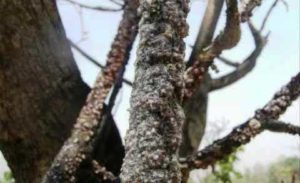 At least 10 kilograms Lac can be produced from a single tree each and every year which cost in the international market is about 400 rupees per kgs, informed a forest official.
At least 10 kilograms Lac can be produced from a single tree each and every year which cost in the international market is about 400 rupees per kgs, informed a forest official.
The district forest department Bokaro is undertaking the cultivation of lac on Palash (Budea monosperma) trees aiming to promote a livelihood option for the poor and to conserve the trees.
Lac production is a livelihood option for both rainfed farmers and forest dependents. It would involve support, cultivation and marketing of the product, said PR Naidu DFO Bokaro. “This mission involves a plan for supplementing the agriculture-based income of these people with high-income generating alternatives and lac cultivation is one such alternative, said DFO adding “though our aim is to conserve Palash tree also”
“Palaash is a very common tree in many parts of Jharkhand, which grows mostly in the degraded soil. We planned using the trees to generate income for the poor villagers in the remote areas. Lac cultivation is easy and reaps profits in a short time,” added DFO.
“If the rural people were encouraged they would not only get supplementary income, but the state would also retain its supremacy in lac cultivation,” added Naidu.
Presently we have started Lac farming on 14000 Palaash trees in Bokaro districts on forest land as well as on private lands, includes 4000 trees in Tiyada villages, 2000 in Silfore and on 8000 trees in Kashijhari villages of the district, he said.
“But we have also plan to start the cultivation of 10 thousand new trees for the month of October,” he added.
According to an estimate 10 kilograms, Lac can be produced from a single tree each and every year which cost in the international market is about 400 rupees per kgs, informed a forest official.
Aiming to promote livelihood we are providing training on Lac production, presently 30 peoples are getting training here at Bokaro, he said. Despite providing training we (forest department) are also conducting awareness drive aiming to encourage the poor, rainfed farmers and forest dependents for Lac farming, said Naidu.
Lac is a secretion from the body of an insect called laccifer or kerria lacca. It secretes lac resin and forms hard resinous layers as the insect goes into the pupa stage. This resin is scraped off, dried and processed to form Lac or shellac.
Naidu explained that Lac was cultivated twice every year known as Baisakh (June-July) and Ketki (October-November) and advanced technology can help in improving the production.
“It’s cultivation, would definitely help people in improving their economic condition”, added DFO.




